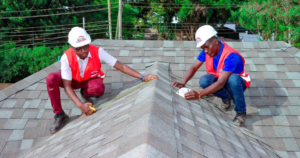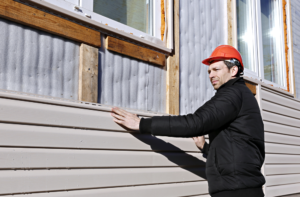The roof is one of the most important parts of a home or building. It protects the interior from rain, snow, sunlight and extreme temperatures.
The roof can be made of various materials. A common type is asphalt shingles. Metal roofing is also becoming popular. It offers a different look and is long-lasting. Contact Roofing Baton Rouge now!

There are many options available for homeowners to choose from when it comes to roofing materials. Each option offers its own unique look and protection while varying in price, durability, and eco-friendliness. Some of the most popular roofing materials include asphalt shingles, wood shakes, clay tiles, and slate. Slate is an extremely attractive and durable roof material that can last for hundreds of years. It is often seen on historic buildings and elegant homes. However, it can be expensive and requires a strong frame.
Regardless of the material you choose, it is important to work with a qualified contractor to ensure your home receives the best roof possible. A good contractor will offer a warranty on their work to protect your investment. This will cover repairs and labor costs for a number of years following the installation.
The first step in choosing a roofing material is determining what type of climate you live in. Your local climate will influence the amount of rain and snow that your roof will need to withstand. You will also need to consider your aesthetic preferences and the design of your home.
Asphalt shingles are a popular choice due to their low cost and resistance to harsh weather conditions. They come in a variety of colors and styles, and can complement almost any home design.
If you want a more rustic look, cedar shakes and shingles are an excellent choice. These natural materials are made from trees that have been roughly milled into individual shakes and shingles, giving the roof a distinctive, rustic appearance. However, they require significant maintenance to prevent drying and deterioration and need to be treated regularly to avoid moss growth.
Tile roofs are made from earthen clays that have been molded into rolled or interlocking shapes and fired for durability. They are a great choice for hot or dry climates, and can withstand high-speed winds, earthquakes, and other severe weather conditions. The downside is that they are a heavy material, and can add a considerable amount of weight to a home.
If you are looking for a more modern roof, you can opt for a synthetic membrane like EPDM or TPO. These membranes are applied in large sheets, which limits the number of seams that can allow water to seep through.
Installation
Roof installation is a meticulous process. Roofing contractors will begin by inspecting your home’s existing roof to determine its condition. This includes removing old shingles, flashing, and underlayment. Once this is complete, the roof deck will be exposed and ready for a new roof.
The contractor will then install a layer of felt paper and a row of shingle tabs that are secured with a vapor retarder, if applicable. The vapor retarder is designed to restrict the passage of water vapor through the roof system. The underlayment is then nailed down, beginning with the bottom edge closest to the ridge of your roof and working toward the center. The underlayment will be nailed down with cap nails that are spaced more closely together near the edge and then spread out farther apart towards the middle.
Depending on your roof, you may have one or more valleys. These are areas where the slopes of your roof meet and form a “V” shape. Water runs through these valleys, so they must be waterproofed. A rubber sealant is applied to all raw edges, and a bead of roofing cement is also added around the bases of any vents or chimneys. This makes the seals watertight and protects against any leaks.
Maintenance
A roof is an integral part of a building structure that protects the interior from rain, snow, sunlight, wind, and extreme temperatures. It can be constructed in a wide variety of forms and styles for aesthetic or technical reasons. A well-maintained roof is a critical component of any structure. It is essential to keep the roof free of debris and properly insulated to prevent water damage. The roof should also be inspected regularly for any signs of wear and tear or damage. Any problems should be addressed immediately to prevent them from escalating.
The maintenance procedures for roofing vary depending on the type of roof. However, all roofing systems need regular inspection and cleaning. For instance, flat roofs need to be free of debris that can scratch or puncture the surface, and drain lines should be clear so that ponding water does not prematurely damage the system. On the other hand, shingle roofs need to be periodically cleaned to remove organic material such as moss that can grow and cause damage.
In addition, any tree limbs that hang over the roof should be trimmed on a regular basis to prevent them from breaking during stormy weather. It is also important to ensure that the caulking around any vents or chimneys are intact and in good condition. For the best results, a roof should be inspected before and after any rooftop equipment repairs.
It is important to keep a record of any inspections and maintenance tasks performed on the roof, as this will help to identify any issues that need to be addressed before they become serious problems. A written document will also be useful in case of any warranty claims or when it comes time to sell the home. For this reason, it is a good idea to establish a schedule for routine inspections and maintenance tasks that is recorded in a logbook or digital file.
Repairs
The key to extending the lifespan of your roof and avoiding costly repairs is preventive maintenance. Regular inspections and timely repairs of small problems such as leaks, sagging areas, or damaged flashing can prevent them from escalating into major issues that require extensive structural work to repair.
A well-maintained roof can also help improve your home’s energy efficiency. Untreated leaks and weakened areas can allow conditioned air to escape and outside air to infiltrate, forcing your heating or cooling system to work harder. Roofing contractors can identify and repair these problems to reduce your energy bills.
Leaks around the pipe collars or base flashing can be a serious issue. The repair process involves carefully removing the existing flashing and shingles to expose the metal collar assembly, which includes the rain cap, storm collar, and the pipe itself. The leaking area is then carefully replaced, and new flashing and shingles are installed to ensure a watertight seal. The cost of this repair depends on the type and extent of damage, as well as the difficulty of the job. If the roof is difficult to access or steep, labor costs will increase. The use of specialized materials or high-quality labor can also increase the price.
Whether you’re planning to sell your house or simply want to improve its curb appeal, a repaired and well-maintained roof can do wonders for your home’s aesthetics. If potential buyers see a damaged roof, they may walk away or ask for a lower price. Performing the necessary repairs can avoid this scenario and help you get top dollar for your property.
